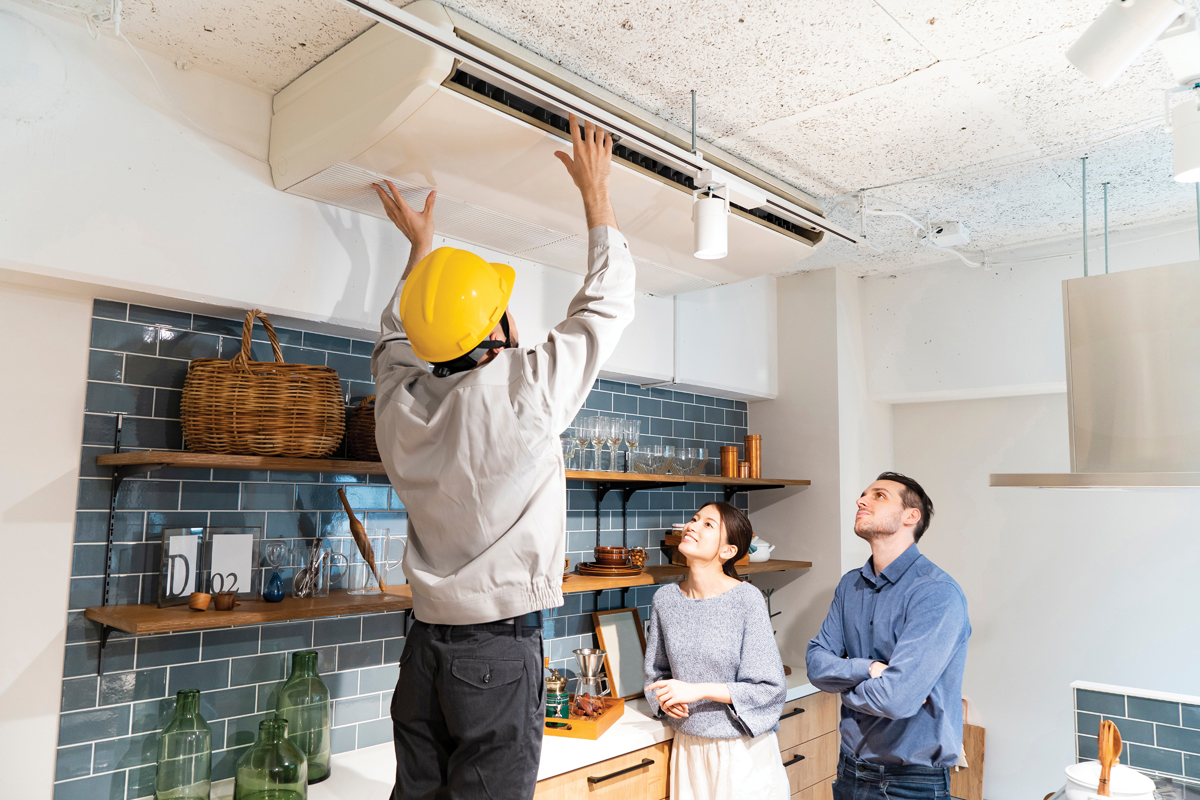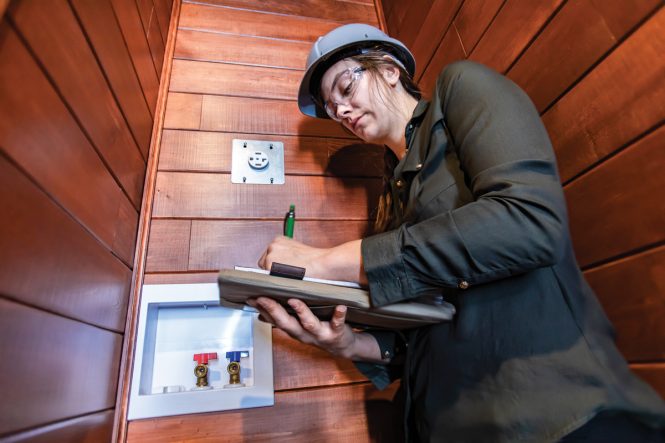An Energy Assessment Conversation with Marcy Cleveland
By Jeff Eckes | Spring 2024 | Home Improvement
As a full-time builder, I work with many gifted professionals to deliver high performance (low-energy use) housing to our clients in the Hudson Valley. One of the most important partners I have in this are the testers and assessors of the technology we use. Testing before the work is contracted on an existing home is essential to getting the right work quoted and performed, testing after that work is done proves that the work was done to specifications.
Homeowners can enlist what is known as an “energy auditor” or assessor, the same exact testers that I use professionally, and the earlier they do that the better the outcome of any energy retrofit like insulation, air sealing, ventilation, and electrification with heat pumps for hot water and heating/AC will go. This year, with so much funding being provided by New York State and the Inflation Recovery Act, it’s even more important to have a real, tested assessment of an entire home’s energy profile.
For some testing (like Passive House and Energy Star certification), an independent certified inspector is required—in all cases it’s simply best practice. For a homeowner, it provides facts that are independent of the contractors you choose to do the work, as well as a scope of work and helps control for those times that you hire a “less-than-perfect” contractor to do the work, and the good news, a basic audit is free to all New Yorkers. Yes, that’s right, free.
For the first episode of my new podcast series, “Passive Aggressive,” I talked with Marcy Cleveland about energy audits. Cleveland is the owner and operator of Green Building Specialists, a home performance assessment company based in Pine Bush. She’s a BPI-certified building analyst and envelope professional and Department of Energy Home Energy Score Assessor, as well as a realtor with a Green Designation and Earth Advantage Broker Certification. (This interview has been edited for length.)
Jeff Eckes: I know you’re as passionate about building science and the climate and as I am, but I also understand that you have a lot of other interests. What is your number one passion right now?
Marcy Cleveland: Everything that I’ve been doing professionally is about identifying and correcting inefficiencies that I see. Those inefficiencies could be in process, it could be in design, or energy inefficiencies. It’s discovering those opportunities for betterment, and how we can do something better. How can we leverage technology to make things easier for us, how do we break down a complex subject and make it easier to understand? That kind of leads into AWE, which we’re going to talk about later.
It’s also about making improvements to your home that add value. Those improvements make homes more comfortable, safer, healthier, and less costly to operate. They also make them more valuable, and what I’m really excited about is: How do people and the planet benefit from these improvements as well? It’s advocating for those changes, promoting these better and more efficient ways of doing things, talking to people, sharing that message, education, and community outreach. A big reward for me is just seeing how these efforts are making a difference for people. They’re happier in their homes because they’re more comfortable.
What you do each day when you go to work?
It depends on what hat I’m wearing—the energy-assessment hat or my realtor hat. My day could look very different, depending on what I’m focused on.
What hat do you wear the most?
Right now, it’s more the energy-assessment side of things, and I like to use the phrase “energy assessment” not “energy audit,” because “audit” has a negative connotation. An assessment is like a doctor’s checkup for your house, for both the exterior and the interior. I’m going to be looking at it and analyzing people’s utility bills, and their current mechanicals. Are they in good condition, running efficiently, how old are they, what type they are? I look at their appliances: are they old? Are they Energy Star rated? What kind of lighting do they have? If you’re still using old incandescent light bulbs, change those out for LEDs, right now.
That’s a broad mandate, how do you acquire the expertise to be an energy assessor?
It’s education. I’ve been through more than a couple of certification courses, and I have a personal goal to get one new certification every year. I’m also not afraid to admit I don’t know something, but I’ll find the answer, and it’s going to be the right answer.

We’re blessed in this industry with a very collaborative group of experts nationwide. With a lot of big brains writing really, really good books and putting out really, really good research. Your mission is obviously green, so what’s your ultimate goal?
I suppose it’s getting the word out about energy assessments, as most important. We’re asking people to do make major changes to their homes to conserve energy, but you’ve got to get your home assessed, and this is where AWE comes in.
You mentioned that, what is AWE?
AWE: assess, weatherize, and then electrify, in that order. One thing that I do as a realtor when I’m working with buyers is to start a conversation very early on about decarbonization and electrification so that they know what they need to do after they purchase an older home. AWE is an easy acronym for people to remember how to do these upgrades, and in what order, so they don’t make the mistake that I have seen so often; thinking they need heat pumps first, since that’s what they hear about, and getting a heat pump company that only cares about making money and feels that informing customers isn’t their job.
What a homeowner needs to do is a natural progression: Assess first and figure out where the problems are. Then weatherize, air seal, and insulate, and air sealing is really important, because insulation is just an air filter if you don’t seal first. Why would you buy a fancy heated coat, when zipping up the one you have usually shows better results? Then, and only then, electrify! That way the systems are sized for a properly sealed and weatherized home. You pay less for equipment, and for the energy to run it for the next 25 years of that equipment’s life!
Is there anything that regular homeowners can do to save money on these processes?
Yes, first, every New York homeowner and renter is entitled to a free energy audit! Get it, it literally does not pay not to. Also, once you have that assessment and have worked with the energy assessor to come up with a plan, you could help remove old insulation, and depending on your skill level, even learn how to do much of the air sealing too. Leave the final details to a weatherization expert though—they are trained to catch details that most are not. If the assessment comes back with problematic things like exposed asbestos, it’s also best to leave that to professionals.
What else do you look for?
Well, if there is natural gas or propane used in the home, we look for leaks. It’s not as unusual to find leaks as you might imagine. Also, we look at water, in all its forms. Liquid water outside, like broken gutters and leaders, can destroy a home. Excess vapor inside can accumulate on windows and walls and create favorable conditions for mold growth. Uncontrolled water of any kind is bad for a home.
Let’s talk about funding—there are a lot of incentives out there right now for this kind of upgrades, isn’t there?
Yes, quite a bit in fact. There is rebate and tax incentive money for assessments, insulation, induction stoves, heat pump water heaters, heat pump heating and air conditioning, and much more. NYSERDA is administering most of these rebates through their Clean Energy Hubs, and is a great resource for information as well. Another source is Rewiringamerica.org, which explains the subject of electrification in an easy-to-digest way.
If you had one thing that you wanted to leave readers with as important, what would it be?
Get a home energy assessment if you haven’t gotten one. They’re free!
Jeff Eckes is the CEO of LDR Group, a Passive House design/build/renovate contractor located in the Mid-Hudson Valley. His new podcast, “Passive Aggressive,” on high-performance housing technologies, is available on podcast platforms.
